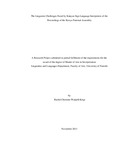| dc.description.abstract | This study set out to investigate the linguistic challenges encountered by the
Kenyan Sign Language Interpreters (KSLIs) of the proceedings of the Kenya
National Assembly (KNA). Interpreting the proceedings of the KNA is a new
dispensation as a result of the Constitution of Kenya 2010. Thus it is a pioneering
activity in Kenya. The study had the objective of establishing whether the KSL
interpreters encounter challenges; whether they are consciously aware of the
challenges and what communication strategies they use to solve these challenges.
Further, the study aimed at establishing and documenting any linguistic
innovations by the KSL interpreters with regard to parliamentary discourse.
The study used the theory of communication strategies which derives from
Tarone through Ellen Bialystok in her Communication Strategies A Psychological
Analysis of Second-Language Use (1990) and provides some examples of
communication strategies such as: avoidance, paraphrase, conscious transfer or
borrowing, appeal for assistance, and mime.
The research was initiated by the designing of Questionnaire 1, followed by
separate face-to-face interviews with the four KSL interpreters of the proceedings
of the KNA. Questionnaire 1 was distributed immediately after the face-to-face
interviews, and responded to immediately or soon thereafter. The recorded faceto-
face interviews were transcribed and subsequently Questionnaire 2 was
designed and distributed by electronic mail. The receipt of responses to
Questionnaire 2 was followed by the analysis of the material from the face-to-face
interviews, Questionnaire 1 and Questionnaire 2.
The study has established that there were linguistic challenges encountered by the
KSL interpreters of the proceedings of the KNA; that these interpreters were
aware, if not always consciously, of such challenges; that most of the
communication strategies used were as outlined by Bialystok; and that there was
minimal innovation in parliamentary discourse glossary by the KSL interpreters
themselves.
Chapter One introduces interpreting and the background to the study based on the
Constitution of Kenya 2010, defines the research objectives, outlines research
hypothesis, posits the significance and rationale of the study as well as the scope
and limitations thereof; describes the theoretical framework, provides the
literature review and concludes with a summary of the research methodology.
Chapter Two introduces the Kenyan Sign Language Interpreters of the
proceedings of the Kenya National Assembly; presents the responses to the data
and examines challenges related mainly to training, parliamentary terms, language
competency and similar skills.
Chapter Three is the nucleus of this research as it analyses the data collected and
works through it on the basis of the theory of communication strategies outlined
by Bialystok (1990).
Chapter Four provides summaries of the findings, as well as various aspects
connected with the responses.
Chapter Five contains the summary, conclusion and recommendations for further
research as well as other possible areas of focus. | en |

